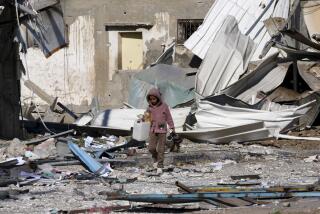U.S. Aid for Besieged Cambodia? : Non-Communist Parts of Resistance Should Get Open Support
Imagine a small, strategically located country invaded and occupied by the army of a militant communist power.
The invader is deeply hostile to the United States, with which it has recently fought a bitter war. The invader is supplied and backed by the Soviet Union. The country under attack has lost perhaps one-quarter of its entire population in the events preceding, accompanying and following the invasion. The invading army faces an indigenous resistance movement--roughly one-half under nationalist, non-communist leadership. The resistance is supported politically by a group of neighboring pro-Western states. President Reagan has indicated that the broader region of the conflict is of paramount interest to American foreign policy.
This scenario, while oversimplified, is real. It describes Vietnam’s occupation of Cambodia. That conflict has recently intruded on American consciousness as a large-scale Vietnamese offensive has overrun major resistance base camps in Cambodia, driving the occupants (including 250,000 civilians) into Thailand and igniting firefights between the Thai and Vietnamese armies.
The Cambodian resistance consists of three groups: the Khmer Rouge, a radical peasant-based, communist organization that ruled Cambodia between 1975 and 1978 with unparalleled brutality, and two non-communist organizations formed in 1979. The non-communists have become a significant force, with about 25,000 men under arms and many thousands more trained but lacking weapons. China has provided the only effective military support for the insurgents, in the form of weapons and military pressure along its border with Vietnam.
Diplomatic condemnation of Vietnam has been led by the Assn. of Southeast Asian Nations (ASEAN), which consists of Thailand, Singapore, Malaysia, Indonesia, Brunei and the Phillipines. ASEAN may be the one positive legacy of our Indochina war. Among ASEAN leaders is a conviction that the decade of U.S. involvement bought time for the non-communist states of the region to get onto their feet. ASEAN members have achieved economic growth rates that are among the world’s highest, and their success has become a powerful advertisement in Afro-Asia for Western-oriented, free-enterprise economies.
At ASEAN’s urging, the U.N. General Assembly has recognized the coalition of resistance organizations as the legitimate government of Cambodia. And last month the ASEAN foreign ministers jointly issued a tough communique condemning Vietnamese aggression and calling for international support--that is, weapons and funds for the resistance. This is the first time that ASEAN has collectively and publicly made such an appeal.
How should the United States respond? To date, Washington has limited its involvement to humanitarian assistance for refugees. There are persuasive reasons to maintain this policy. It keeps the conflict at arm’s length, avoids disturbing the uneasy political ghosts of the Vietnam War, and doesn’t jeopardize painful negotiations with Hanoi over the recovery of missing-in-action remains.
However, there are other considerations, and, if events proceed on their present course, one of two results is likely:
First, the Cambodian resistance will be ground down by superior Vietnamese firepower, and international political support for the insurgents will want. The recent movement of Vietnamese settlers into Cambodia will accelerate, and a process of Vietnamese colonization will effectively eliminate Cambodia as a nation, probably leaving the remaining Cambodians as a minority in their own country. meanwhile, a huge Cambodian refugee influx will place heavy burdens on Thailand.
A second possibility is that China will try to forestall the first outcome, even at great cost. This will require a massive Chinese invasion of Vietnam--far exceeding the scale of 1979, when thousands of Chinese troops crossed the Vietnamese border.
Vietnamese absorption of Cambodia would eliminate the historic buffer between Vietnam and Thailand. Southeast Asia would be radically divided between a garrisoned Soviet-aligned, Marxist mini-empire and a grouping of pro-Western, pluralist societies.
Alternatively, the Chinese attempts at a military solution could mean a new Indochina war. One likely consequence, anatheme to all states of the region, would be a greatly expanded Chinese role in the affairs of Southeast Asia. Already the emergence of China as the major military supplier and protector of the insurgents has caused profound uneasiness.
American and ASEAN interests require the continued existence of an autonomous Cambodia--even one heavily influenced (but not occupied) by Vietnam. Failure to achieve this minimum objective would jeopardize the cohesion and security of ASEAN and cast new doubts on the ability of the United States to defend its interests in the region.
Hanoi will not be persuaded to alter its course unless the costs of its present policy become unsupportable. This will occur only if a combination of pressures are brought to bear: Chinese politico-military coercion, international diplomatic isolation, economic deterioration (particularly compared to ASEAN success) and growing military pressure from the Cambodian resistance. If the insurgents are to be effective, they must be better trained and supplied. This will require American money and equipment.
Aid can be restricted to the non-communist components of the resistance. It can be supplied to ASEAN, which can handle distribution and training. The result would be a low-profile, but not covert, American role. There need be no concealment of support for legitimate national and humanitarian interests.
More to Read
Sign up for Essential California
The most important California stories and recommendations in your inbox every morning.
You may occasionally receive promotional content from the Los Angeles Times.










